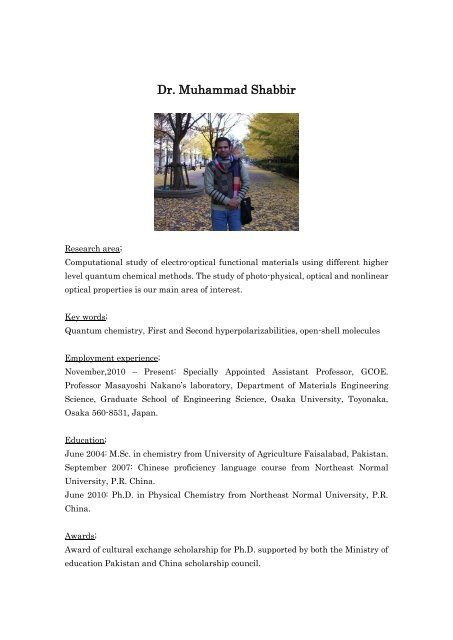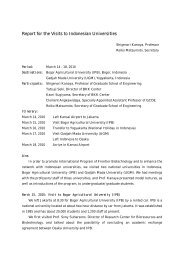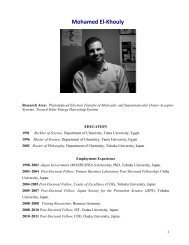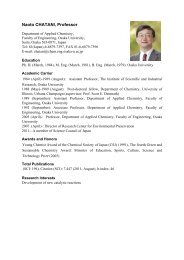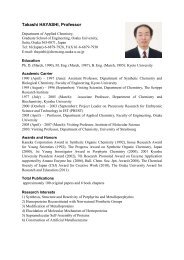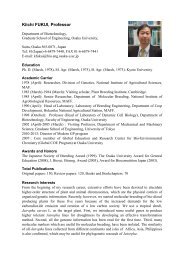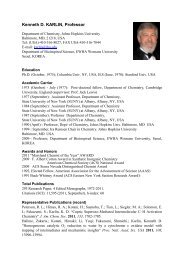Dr. Muhammad Shabbir - Osaka University
Dr. Muhammad Shabbir - Osaka University
Dr. Muhammad Shabbir - Osaka University
Create successful ePaper yourself
Turn your PDF publications into a flip-book with our unique Google optimized e-Paper software.
<strong>Dr</strong>. <strong>Muhammad</strong> <strong>Shabbir</strong><br />
Research area;<br />
Computational study of electro-optical functional materials using different higher<br />
level quantum chemical methods. The study of photo-physical, optical and nonlinear<br />
optical properties is our main area of interest.<br />
Key words;<br />
Quantum chemistry, First and Second hyperpolarizabilities, open-shell molecules<br />
Employment experience;<br />
November,2010 – Present: Specially Appointed Assistant Professor, GCOE.<br />
Professor Masayoshi Nakano‟s laboratory, Department of Materials Engineering<br />
Science, Graduate School of Engineering Science, <strong>Osaka</strong> <strong>University</strong>, Toyonaka,<br />
<strong>Osaka</strong> 560-8531, Japan.<br />
Education;<br />
June 2004: M.Sc. in chemistry from <strong>University</strong> of Agriculture Faisalabad, Pakistan.<br />
September 2007: Chinese proficiency language course from Northeast Normal<br />
<strong>University</strong>, P.R. China.<br />
June 2010: Ph.D. in Physical Chemistry from Northeast Normal <strong>University</strong>, P.R.<br />
China.<br />
Awards;<br />
Award of cultural exchange scholarship for Ph.D. supported by both the Ministry of<br />
education Pakistan and China scholarship council.
Best poster award in 27 th congress of Chinese Chemical Society held in 20-23 June<br />
2010, Xiamen, China.<br />
Selected publications;<br />
1. <strong>Shabbir</strong> <strong>Muhammad</strong>, Hongliang Xu, Yi Liao, kan Yuhe, Zhongmin Su “Quantum<br />
Mechanical Design and Structure of Li@B10H14 Basket with Remarkably<br />
Enhanced Electro-Optical Response J. Am. Chem. Soc. 2009, 131 (33),<br />
11833–11840.<br />
2. <strong>Shabbir</strong> <strong>Muhammad</strong>, <strong>Muhammad</strong> Ramzan Saeed Ashraf Janjua, Zhongmin Su<br />
Investigation of dibenzoboroles having π-electrons: Towards a new type of two<br />
dimensional NLO molecular switch? J. Phys. Chem. C, 2009, 113, 12551–12557.<br />
3. <strong>Shabbir</strong> <strong>Muhammad</strong>, Chunguang Liu, Liang Zhao, Shuixing Wu, Zhongmin Su<br />
“A theoretical investigation of intermolecular interaction of a phthalimide based<br />
„„on–off‟‟ sensor with different halide ions: tuning its efficiency and electro-optical<br />
properties.” Theor. Chem. Account, 2009, 122, pp 77-86<br />
4. <strong>Shabbir</strong> <strong>Muhammad</strong>, Hongliang Xu, Zhongmin Su “A Quantum Chemical Study<br />
of Benzimidazole Containing Molecules to Tune the Nonlinear Optical Switching by<br />
Proton Abstraction.” Phys. Chem. Chem. Phys., 2010, 12(18): 4791-99.<br />
5. <strong>Shabbir</strong> <strong>Muhammad</strong>, Hongliang Xu, Zhongmin Su “Capturing a Synergistic<br />
Effect of a Conical Push and an Inward Pull in Fluoro Derivatives of Li@B10H14<br />
Basket: Toward a Higher Vertical Ionization Potential and Nonlinear Optical<br />
Response” J. Phys. Chem. A, 2011,DOI: 10.1021/jp110401f.<br />
Research Statement;<br />
In the modern optical communication systems, the fast replacement of electron by<br />
photon as a carrier of information has kept the design of different types of nonlinear<br />
optical (NLO) materials in the spotlight of scientific interest. Ab initio methods<br />
together with finite field (FF) approach are usually used to compute first and second<br />
hyperpolarizabilities, and , which are the origins of the macroscopic second- and<br />
third-order nonlinear optical (NLO) susceptibilities, χ 2 and χ 3 , respectively. Some<br />
recent studies have shown that few classes of push-pull NLO chromophores<br />
containing an electron donor, a conjugated (pi) network, and an electron acceptor<br />
are good single-molecule labels. Thus, NLO chromophores are potential candidates<br />
for designing reversibly switchable nanoscale emitters not only for single-molecule<br />
optical imaging in living cells but also for NLO microscopy. Near-infrared or<br />
nonlinear NLO chromophores have several advantages over visible fluorophores,
including improved tissue penetration, a significant ground-state dipole moment,<br />
sensitivity to local environment and lower auto-fluorescence for example<br />
indocyanine green. In the present study, a molecular-level description about these<br />
NLO chromophores will be provided which can revolutionize the field.<br />
My goal;<br />
Recently, Nakano et al. have reported that open-shell molecular systems can exhibit<br />
larger third- order NLO properties than closed-shell systems. According to this<br />
guideline, our goals include selection and modification of different recent<br />
computational methodologies to study the second-/third-order NLO properties using<br />
a more accurate, concise and detailed way in photolytic radicals, single wall carbon<br />
nanotubes, and open-shell compounds which have been considered a complicated<br />
task due to the multireference (MR) character of wave function in computational<br />
chemistry. Besides this, the use of different modified and selected methodologies to<br />
design new families of NLO chromophores, which have been considered difficult to<br />
deal in experimental chemistry due to high reactivity of open shell radicals. The<br />
long-term goal includes the continued development of high performance NLO<br />
chromophores and to modulate reversibly their second-order polarizability (by light<br />
and pH) and third-order polarizability (by change in spin state, charge state,<br />
applying external static field). The future outlook includes the designing of<br />
switchable NLO chromophores along with the elucidation of their integration<br />
mechanism to help in understanding their environmental sensitivity for imaging of<br />
single molecules.


